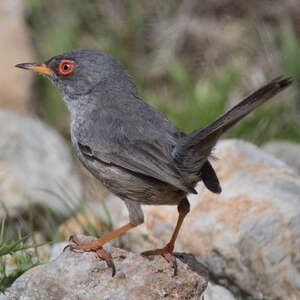Balearic Warbler
Curruca balearica - Fauvette des Baléares
Identification
This Balearic Warbler looks like a small Sardinian Warbler, a species with which it forms a superspecies and which it was once considered a subspecies of. In the adult male, the upper part is grey (a bit paler than the Sardinian Warbler), the underside is of a slightly pinkish grey (leaden-grey in the Sardinian Warbler) and the throat is whitish and not dark. There is a bright red eye-ring. The legs are of a quite bright orange. Females and juveniles are less brightly coloured and very difficult to differentiate from those of the Sardinian Warbler.
Subspecific information monotypic species
Foreign names
- Fauvette des Baléares,
- Curruca balear,
- toutinegra-das-baleares,
- Balearengrasmücke,
- baleári poszáta,
- Balearische Grasmus,
- Magnanina balearica,
- balearisk sångare,
- Balearsanger,
- penica baleárska,
- pěnice baleárská,
- Balear-sanger,
- baleaarienkerttu,
- tallareta balear,
- pokrzewka balearska,
- Baleāru ķauķis,
- Балеарская славка,
- バレアレスムシクイ,
- 巴岛林莺,
- balearisk sångare,
- 巴里亞利林鶯,
Voice song and call
Habitat
Behaviour character trait
Dietfeeding habits
The Balearic Warbler mainly feeds on small invertebrates. However, it also consumes small fruits like those of the lentisk mastic tree. It gathers a large part of its food from the ground or from the lower parts of vegetation. It also sometimes catches insects in flight in the manner of a flycatcher.
Reproduction nesting
The reproduction extends from March to June, with couples raising two broods, sometimes three. The nests are placed low in a bush (average 0.
m). Both sexes participate in the construction of the nest, which takes the form of a small and solid cup made of stems of grass and leaves, and lined with finer stems, rootlets and hair. The males build additional nests that will not be used for reproduction. The eggs, 2 to 4 per clutch (average 3.1 eggs/clutch), are incubated by both sexes for 12 to 15 days. The chicks, fed by both parents, leave the nest after about a dozen days.Geographic range
Threats - protection
IUCN conservation status
concern
in the Wild
threatened
evaluated
With a population of around 20,000 pairs, the Balearic Warbler is not threatened. However, it disappeared from Minorca during the 1980s. This disappearance is thought to be due to strong competition from the Lesser Whitethroat (but this hypothesis is not accepted by all researchers).
Sources of information
- IOC World Bird List (v15.1), Gill, F and D Donsker (Eds). 2025-12-07.
- Le guide ornitho : Le guide le plus complet des oiseaux d'Europe, d'Afrique du Nord et du Moyen-Orient : 900 espèces, Svensson, Mullarney, Zetterstrom
- Les passereaux d'Europe, tome 2, P. Géroudet, M. Cuisin
- Vol. 11 - Handbook of the Birds of the World, Josep del Hoyo, Andrew Elliott and David Christie
- xeno-canto, Sharing bird sounds from around the world,
- HBW Alive,
- Birds of the Western Paleartic interactive, Cramp Simmons
- Identificació del busqueret coallarga (Sylvia sarda balearica)., Gargallo G.
- The birds of the Iberian Peninsula, de Juana E. Garcia E.
- Sylvia warblers. Identification, taxonomy and phylogeny of the genus Sylvia, Shirihai H., Gargallo G. Helbig A. J.
Other sources of interest
 Specification sheet created on
30/07/2023 by Georges Olioso
Specification sheet created on
30/07/2023 by Georges OliosoTranslation by AI Oiseaux.net
© 1996-2025 Oiseaux.net
- Accipitriformes
- Aegotheliformes
- Anseriformes
- Apodiformes
- Apterygiformes
- Bucerotiformes
- Caprimulgiformes
- Cariamiformes
- Casuariiformes
- Charadriiformes
- Ciconiiformes
- Coliiformes
- Columbiformes
- Coraciiformes
- Cuculiformes
- Eurypygiformes
- Falconiformes
- Galliformes
- Gaviiformes
- Gruiformes
- Leptosomiformes
- Mesitornithiformes
- Musophagiformes
- Nyctibiiformes
- Opisthocomiformes
- Otidiformes
- Passeriformes
- Pelecaniformes
- Phaethontiformes
- Phoenicopteriformes
- Piciformes
- Podargiformes
- Podicipediformes
- Procellariiformes
- Psittaciformes
- Pterocliformes
- Rheiformes
- Sphenisciformes
- Steatornithiformes
- Strigiformes
- Struthioniformes
- Suliformes
- Tinamiformes
- Trogoniformes


















